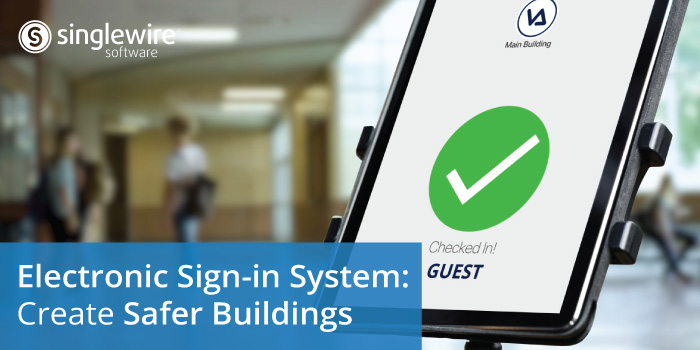Strengthening Building Security with Electronic Solutions
Whether it’s an office, hospital, school, or manufacturing plant, building security should be a top priority for any organization. If buildings aren’t secure, people and operations can be put at risk, which is why it’s so crucial to know who organizations are letting into their buildings. However, when it comes to guest sign-in processes, traditional methods often lack effectiveness. Pen-and-paper sign-in sheets are vulnerable to manipulation, making it difficult to verify identities and prevent unauthorized access. This is where an electronic sign in system becomes valuable. In this blog post, we’ll dive into the shortcomings of traditional pen-and-paper sign-in methods and highlight the benefits of implementing an electronic system to enhance building security and guest verification processes.
Shortcomings of Pen-and-Paper Sign-in
The flaws of pen-and-paper sign-in systems are evident once you start digging deeper into their limitations. Here are some of the key shortcomings:
- No way to verify guest identities: With pen-and-paper sign-in, there is no foolproof way to ensure that the person signing in is indeed who they claim to be. Anyone can jot down a name and check-in time without any verification.
- Difficult to enforce/easy for someone to bypass: Without a standardized procedure in place, it becomes challenging to enforce the sign-in process consistently. This makes it easy for someone to bypass the system altogether, compromising building security.
- Easy to manipulate: Any person can easily input a fake name or check-in time, resulting in inaccurate records and potential security breaches.
- Handwriting legibility issues: Handwriting can vary from person to person, and sometimes it can be challenging to read. Illegible entries lead to inaccuracies and unusable information, defeating the purpose of maintaining visitor logs.
- No way to prevent unwanted guests from entering: Pen-and-paper sign-in provides no mechanism to prevent unwanted individuals from entering a building. In most cases, the individual is already inside the building to sign the sheet, meaning there is no barrier for them to gain access.
Benefits of Electronic Sign in System
Now let’s explore the benefits of implementing an electronic sign in system to overcome the limitations of the traditional pen-and-paper method.
- Creates a standard procedure: An electronic sign in system creates a standardized procedure that everyone needs to follow when entering a building. This includes presenting a photo ID and having their picture taken, ensuring a higher level of security and accountability.
- Verifies guest identity: The electronic system verifies guest identities through various methods such as scanning a government-issued ID or matching their photo to a database. This process minimizes the risk of fraudulent entry and enhances building security.
- Flags potential issues: Integrate an electronic sign in system with watchlist databases or banned visitor lists to automatically screen visitors and flag potential security concerns. This proactive approach helps prevent unwanted individuals from entering the premises by providing a means to intervene before an issue escalates.
- Creates a digital logbook: Electronic sign in systems generate a digital logbook that is easy to access and read. Each entry contains accurate information about guest names and check-in times, providing a reliable record for future reference.
- Prints badges: An electronic system can also print badges for permitted guests. These badges act as proof that guests have followed the required sign-in procedures and that the staff have allowed them within the building. This visual representation provides a quick and easy way to identify authorized individuals.
Implementing an electronic sign in system can revolutionize the way buildings manage visitor access. It enhances security, prevents unauthorized entry, and creates a systematic approach to guest verification. By replacing outdated pen-and-paper methods, businesses and organizations can ensure the safety of occupants while maintaining accurate and accessible visitor records.
At Singlewire Software, we specialize in cutting-edge electronic sign in systems that cater to the unique needs of various industries. Our solutions provide a seamless and secure visitor management experience, enabling you to create safer buildings and peace of mind for everyone involved. To learn more about how an electronic sign in system can enhance your building’s security, visit our Visitor Aware page.
